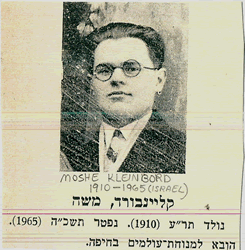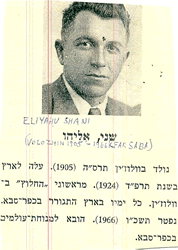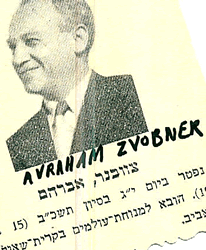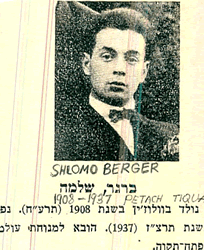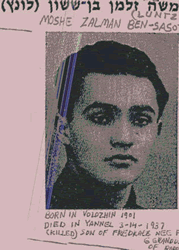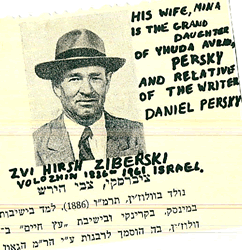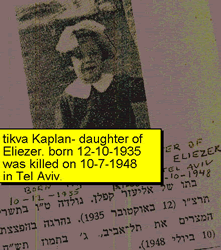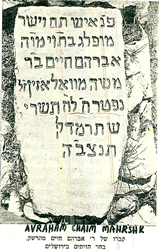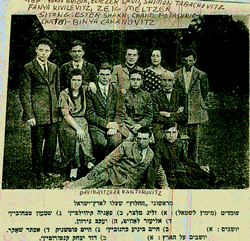#voli-15:
Volozhin Descendants in Israel
THE MULTI-SHTETL MEMORIAL SERVICE OF SHOAH MARTYRS FROM
RADUSHKOVITSH, KRASNE, HORODOK, RAKOV, AND VOLOZHIN
On the Wednesday evening of March 22, 2006, the Multi-Shtetl Memorial Service took place in the Wizo House, located on 38 David Hamelekh Street in Tel Aviv. On the agenda were speeches from shtetl representatives, El Mole Rahamim & Kaddish, candle lighting, refreshments. The purpose of the Azkara was to preserve the memory of our annihilated congregations to the young generation. In the hall, about eighty people assembled, mostly Radushkovitsh and Horodok descendants, with fifteen Volozhiners sprinkled in their midst.
Dr. Isaak Zilburg conducted the ceremony. The shtetls’ representatives delivered speeches. Radushkovitsh was represented by Tsila Zilburgh, Horodok by Yakov Edelman, Rakov – Grinholz, Krasne – Shimon Grinhoyz, Smorgon –Shlomit Dubrovski, and Volozhin by Moshe Porat-Perlman. Brunia Rabinovitsh from Horodok recited Yiddish poetry. Leyzer Shimon Itshe’s son said Kadish in Ashkenazi Hebrew with the true Volozhin dialect and intonation. (On May 10, 1942, at the second mass murder where two thousand people were murdered, Leyzer broke a hole in the roof. With his father’s benediction, “Fly my son, save yourself. The Almighty will help you,” he ran into the woods, joined the partisans and then the Red Army, ultimately living in Volozhin until he made Aliya in 1991).
The group of Volozhin-born people who had survived the Holocaust and witnessed the Israel state’s revival is diminishing quickly with each passing year. Last year we memorialized eight persons. This year we were informed about the decease of the following people:
Ester-Etl Lurie and Beila Beit Halahmi, daughters of Mordkhay and Braha Potashnik, made Aliya in 1932 and passed away in Israel.
Benyamin Wand Polak, son of Michael and Ester, passed away in Tel Aviv.
Rivka Rapoport, daughter of Moshe and Ester, passed away in Australia. Both of them had been exiled by the Soviets to Siberia in 1940.
MAY THEY REST IN PEACE!
Europe’s friendly negotiations with Iranian and Hamas leaders and these leaders’ recent visit to Moscow bring to mind the late thirties. Chemberlain Daladier’s conversations in Munich and the German foreign minister’s talks in Moscow are echoed in these modern events. Few of us still retain these events in vivid memory. The Ribentrop-Molotov secret agreement was signed in Moscow on August 27, 1939. Five days later, on September 1, 1939, Hitler invaded Poland; German fascists and Russian communists divided Poland between them. Each took his part and the Second World War broke out. However, the “Cordial Alliance” lasted only twenty-one months. The Germans’ broke the treaty and attacked their Soviet ally on June 22, 1941. In the first week of combat, the Germans took control of all of Western Belarus and the Ukraine including Vilna, Minsk and all of the shtetls between them. The Holocaust had started.
In the autumn of 1941, two years after the German foreign minister’s visit to Moscow, another German minister arrived in the USSR, this time in occupied Minsk (fifty miles from Volozhin): Himmler, Hitler’s head of the Gestapo. He came to oversee his SS commandos’ in their killing operations. He found the shootings, conducted in full view of the local population, both gruesome and inefficient. Orders were sent to install gas chambers in the death camps and to convey the victims there by train. Despite the new method, our shtetls’ inhabitants, like the majority of the Soviet Jews, were murdered inside their natal town borders according to the old methods: by shooting, strangling and burning, in pits, river beds, barns, synagogues and at home.
The genocide procedures in all of our communities were almost similar.
After the Germans entered a community, they first appointed local anti-Semites as policemen to arrange a “mini-slaughter,” killing a small group of respectable congregation members. The policemen also hung out written announcements which ordered every Jew to put yellow six-point stars on his breast and spine, and forbade under pain of death any aid to the Jews. During the first days of occupation, the Germans and their local Politsay assistants would establish inside the village fenced ghettos/starvation camps that enclosed all the nearby Jews. Here they were forced to perform various difficult and usually humiliating labors. The “Shissbefel” – “Shoot-to-kill Order” was spread by the SS – Gestapo, police and local politsay were called to kill any Jew who was seen outside the ghetto fence. The perpetrators filled out this order ardently whenever they could.
The true bestial genocide began in the fall of 1941 and ended the next fall. The death operations started usually at night, first by encircling the ghetto with armed men. SS and local politsay cornered the Jews, beating and executing the miserable inhabitants in groups of fifty to a hundred men, women, and children. The murderers went from shtetl to shtetl and exterminated their inhabitants. In Rakov on February 42, 928 Jews were killed, In Radushkovits in March 1942 – 900 Jews, in Volozhin in May 1942 – 2000 Jews, in Vishnevo in June 1942 – 1600 Jews, in Horodok in July 42 – 900 Jews and so on.
The perpetrators, assisted by the local anti-Semites, combed the surrounding areas after each slaughter and killed all the hidden Jews when they were found. The Germans murdered the Jewish population by thousands in the important cities, by hundreds in the small shtetls’ and also single families in the innumerable country hamlets like Zabrezhe, Mijeyk, Brilki, Rudnik, Belokorts, Adampol, Hord’k, Dubin, Yuzefpol, Sakovshtshina. By the time the perpetrators finished their work, the entire country had became Iuden Rein, clean of children, women, and men of Jewish provenance. Among the 3000 Jews who had lived in Volozhin, 1000 were children under thirteen. Not a single one was alive after the fall of 1942. All of them were murdered. May the Almighty avenge the innocent rivers of blood!
Western Belarus and Ukraine, where Jewish life and culture had flourished for centuries in severe conditions, became a vast cemetery for more than a million of Jews. Expeditions of youth are organized to visit the sites of extermination in Poland, but the birth country of our annihilated parents is ignored. What can influence our children and their guides to deviate from their course and also visit the region between Vilna and Minsk? Ms. Eilat bought her parents’ house in order to install there the memories of the shtetl. Should not we do the same and establish a historical memorial inside our great Yeshiva? The building was renewed and belongs now to the Union of Jewish Congregations in Belarus
Moshe Perlman
#voli-16:
summer of 2012 near Haifa
From right: Shmuel Yizhak Shvarzberg (son of Joseph of Volozhin), Arye
Shvarzberg of Ivanitz, Meir Bazelet and his brother Zeevik Shvarzberg
(both sons of Mordechai Shvarzberg)
credit: Harel Shvarzberg <harelshv@gmail.com>

